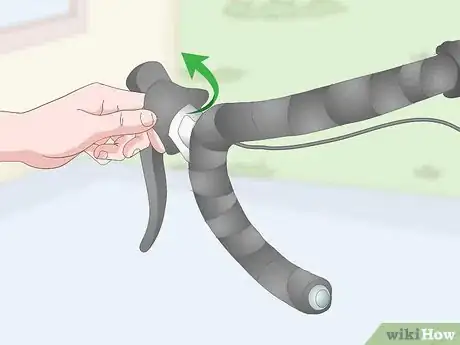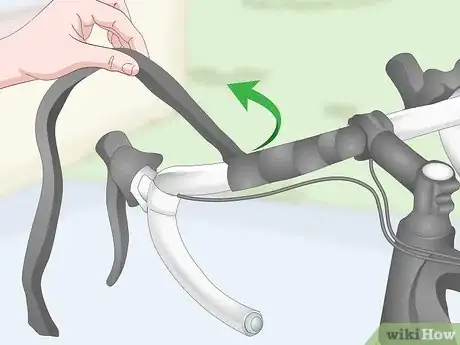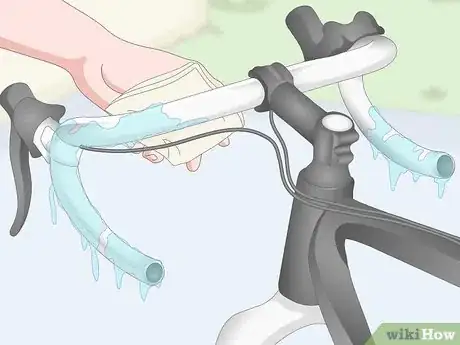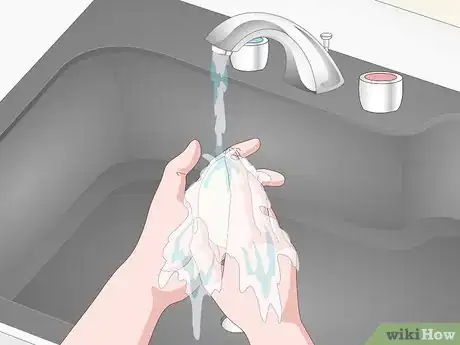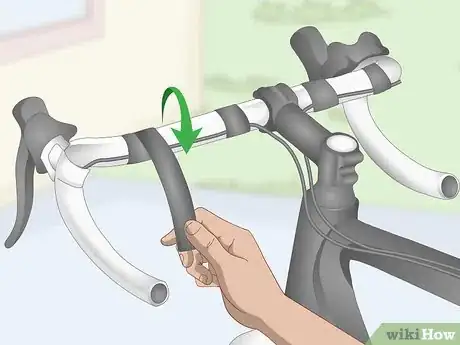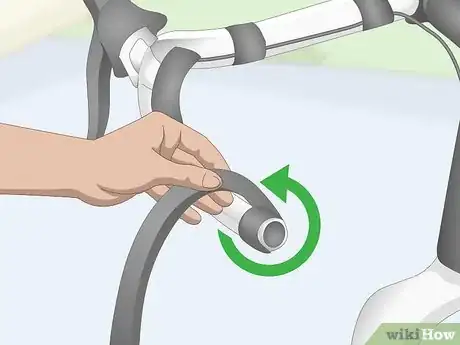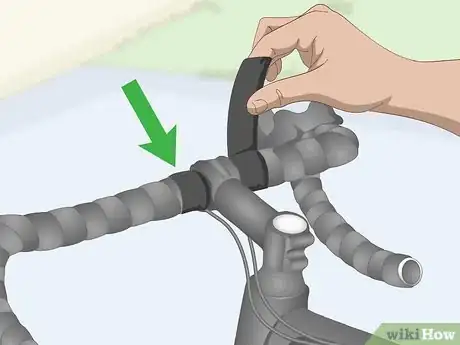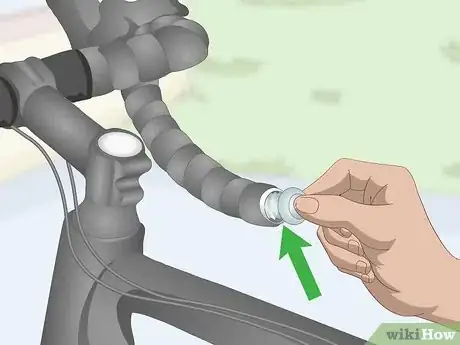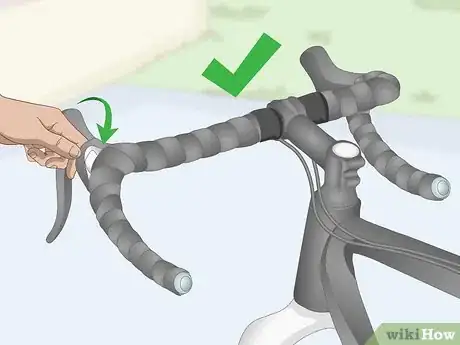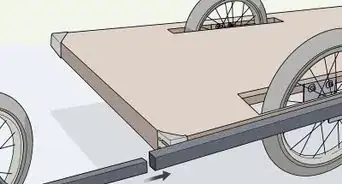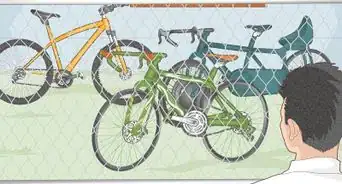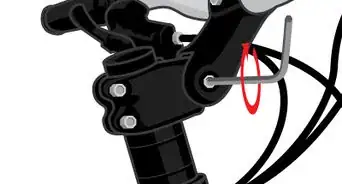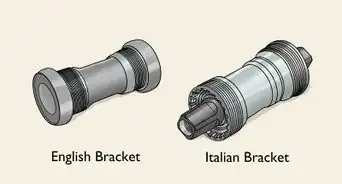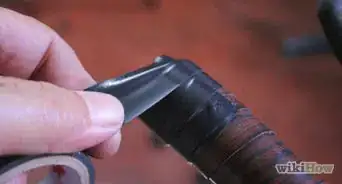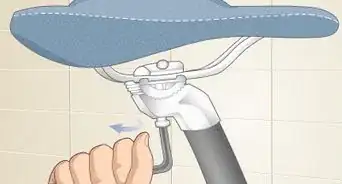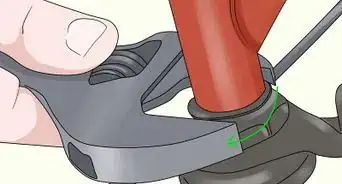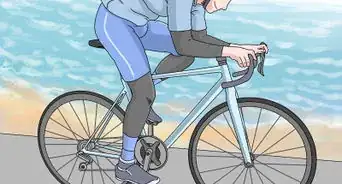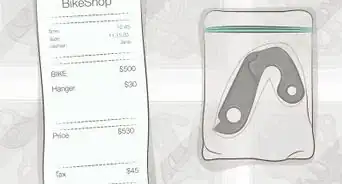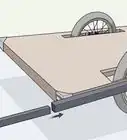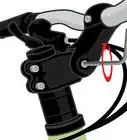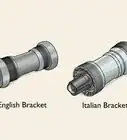This article was co-authored by wikiHow Staff. Our trained team of editors and researchers validate articles for accuracy and comprehensiveness. wikiHow's Content Management Team carefully monitors the work from our editorial staff to ensure that each article is backed by trusted research and meets our high quality standards.
There are 8 references cited in this article, which can be found at the bottom of the page.
This article has been viewed 45,101 times.
Learn more...
The original tape on your bicycle handlebars will wear out with time and use. However, replacing the tape is a quick and easy project. You will just need to remove the old tape and any residue, wrap the tape neatly around the handlebars, and finish off the ends cleanly. Replacing the tape on your handlebars will allow you to maintain a firm grip on the bars, and it will keep your handlebars looking great.
Steps
Cleaning Off the Handlebars
-
1Flip back the brake lever hoods. Most handlebars that are taped have flexible covers that fold over the connection between the brake handles and the handlebar. Flip the end of these hoods back over themselves, towards the brake handle. The goal is to get the end off the bars so that the wrapping can go under them.[1]
- The brake hood lies on top of the brake lever and provides a comfortable grip.
-
2Remove the old tape. Using your fingers, start peeling off the existing tape starting at the center of the bars. There may be a piece of electrical tape holding the end in place, but this can be peeled off just like the bar tape can.[2]
- If the old tape disintegrates or breaks apart, try using isopropyl alcohol to remove any adhesive without causing any damage.
- Do not cut off the tape. You may scratch the metal on the bars or nick your cables if you use a razor blade or scissors to remove it.[3]
Advertisement -
3Pull out the bar plugs. There should be plugs in both ends of the handlebars that are holding some of the bar tape inside the end of the bars. These can typically be wiggled and pulled out with your fingers.[4]
- However, if they are inside the bars securely, when you have peeled off the old tape, pulling the end out will loosen the plugs.
-
4Clean the handlebars and let them dry completely. Remove any dirt and glue left behind on the bars by scrubbing them with a rag and de-greasing cleaner or soap. If everything doesn't come off easily, you can go over the bars with rubbing alcohol to clean any stubborn spots.
- Allow the handlebars to dry completely before rewrapping the handlebars.
-
5Adjust the brake levers. Brake levers are located at the front of the curved part of the handlebars. They are depressed to bring the bicycle to a stop. To adjust them, unscrew the screw on the brake lever to be able to move it. Once unscrewed, move it up, down, or to the side of the handlebar if needed. Screw it back tightly into place once adjusted.[5]
- The bottom of each handlebar on one side should be level with the bottom of each corresponding lever. Each brake lever should also be level with the side of its corresponding bar. Hold a ruler along the bottom to check if it’s level or not.
- Having the brake levers in the correct position will help ensure that the handlebar tape can be wrapped around them and will not be disturbed by repositioning the levers. Set a level across the hoods to make sure they’re in an even position.
-
6Wash your hands. Clean your hands with soap and water if any debris from the old wrap has gotten on them. This is especially important if you are applying white or light-colored tape.[6]
- You may wear gloves to keep from getting the tape dirty.
Applying the Tape
-
1Tape down the cables. Secure any cables that run along the handlebars with electrical tape. Some bikes feature cables that run along the handlebars to the brake pads. This cable system allows you to brake the bike with your hands instead of using the pedals to come to a stop.[7]
- To cut the tape, have a pair of sharp scissors nearby.
-
2Tape the brake lever. Detach the two short pieces of tape that typically come with a new roll of handlebar tape. Place each one of the strips over the back of each brake lever. Ring the tape up around the brake lever so that the inside of the curve of the handlebar is covered.[8]
- Placing a piece of tape in this spot ahead of time will ensure that there is no gap in the tape as you wrap it.
-
3Start your tape hanging over the end of the handlebar. Attach the beginning of the roll of tape to the bottom end of the handlebar so that half of its width is hanging off the end. This extra tape at the end of the bar will be secured later.
- The end of the tape should still be stuck to the handlebar, as the adhesive on the tape is in the center.
-
4Wrap the tape around the handlebar with overlapping layers. Overlap each pass by about a third as you continue taping. Make sure all spots are taped. Move up the curve and along the flat part of the bar towards the center of the handlebars.[9]
- Wrap in a counter-clockwise direction on the right handle and a clockwise direction on the left handle.
- Alternate wrapping from the inside to the outside to create a “figure-8” pattern so you don't need to use an extra piece of tape on the brake lever.[10]
- Keep the tape tight as you wrap. Do not pull so hard that you wrinkle the tape or tear it but don't let it be loose.
- As you wrap up around the brake lever, make sure the extra piece of tape you added stays flat.
-
5Secure the end of the wrapping with electrical tape. Wrap electrical tape around the end of the bike tape and the bar in order to secure it. Keep some tension on the electrical tape as you wrap it around the end of the handlebar tape. This will ensure that the electrical tape sticks to the bar.[11]
- Try to use an electrical tape that is the same color as the handlebar tape. This will help it blend it.
-
6Insert the bar plug. Place the remaining tape at the end of the curved part of the handlebar into the hole at the end of the bar. Insert the bar plug into the hole at the end of the bar.[12]
- You may need to use quite a bit of pressure to get the plug in the end of the handlebars. If pressing with the heel of your hand doesn't work, use a soft mallet to get it in.
-
7Flip down the brake lever hoods and inspect your work. Make sure that all ends are secure. Also look over the whole surface to make sure that each wrap is overlapped and there are no areas of the handlebars visible between the wraps.[13]
- The handlebars are now taped and you are ready to ride!
Things You'll Need
- Handlebar tape
- Electrical tape
- Scissors
- Rubbing alcohol
- A piece of cloth
- Soap and water
- Gloves (optional)
References
- ↑ https://www.bikeradar.com/us/road/news/article/how-to-wrap-bar-tape-video-40425/
- ↑ https://youtu.be/TBoLIY-7M8E?t=20
- ↑ https://youtu.be/TBoLIY-7M8E?t=24
- ↑ https://www.bikeradar.com/us/road/news/article/how-to-wrap-bar-tape-video-40425/
- ↑ https://youtu.be/TBoLIY-7M8E?t=35
- ↑ https://www.bikeride.com/drop-handlebar-tape/
- ↑ https://www.bikeride.com/drop-handlebar-tape/
- ↑ https://www.bikeride.com/drop-handlebar-tape/
- ↑ https://www.bikeride.com/drop-handlebar-tape/
About This Article
To replace the tape on your bicycle handlebars, flip back the brake lever hoods and pull out the plugs on the ends of the handlebars so you can remove the old tape. If the old tape disintegrates or breaks apart as you unwrap it, try using isopropyl alcohol to remove the adhesive. Then, scrub the handlebars with a rag and de-greasing cleaner or soap, and then let them dry completely. Before applying the new tape, start by using electrical tape to secure the cables running along the handlebars, and then tape down the brake levers. To begin the new tape wrapping, attach the beginning of the roll to the end of the handlebar and start wrapping the tape around in tight, overlapping layers. When you reach the center of the handlebars, secure the end of your wrapping with electrical tape. For tips on how to check that your new tape is secure, keep reading!
